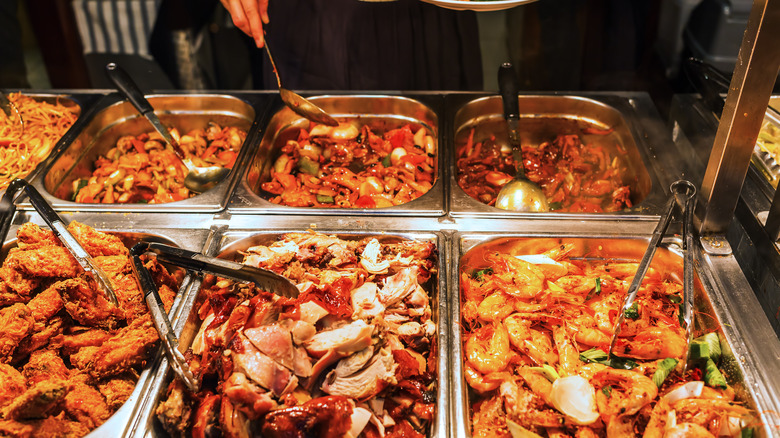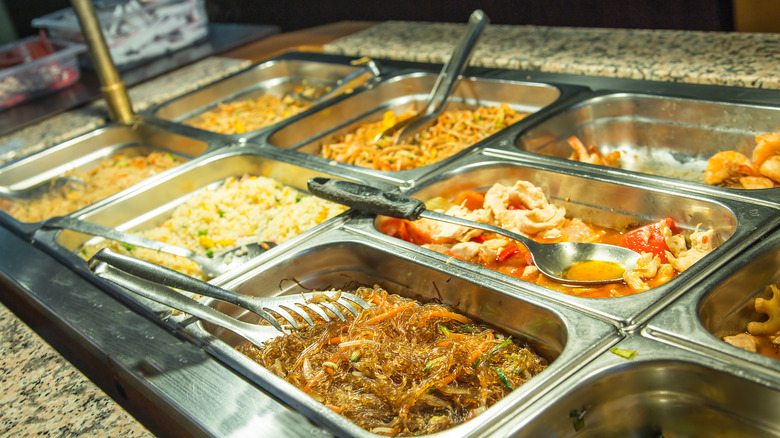Here's What Dining At A Chinese Buffet Was Really Like In The 90s
What is something distinctly "90s?" What is something you think of that makes you think "Oh, that is definitely something I remember from the 1990s?" It can be anything, such as music genres (ska, grunge, etc), political events, fashion styles, and even certain foods and drinks. But one thing that some may consider a perfect representation of that decade is something others may find surprising: Chinese restaurants.
Now, to be sure, Chinese restaurants aren't unique to the 1990s in the same way grunge music, Bill Clinton, and fanny packs are. Chinese restaurants in America go back many years before the 1990s, dating as far back as the late 1800s. It took many years of both Chinese and American influences to even get the Chinese foods we enjoy today, let alone the kinds of Chinese food that were enjoyed by Americans in the 1990s. But if that's the case, why exactly are Chinese restaurants considered by some to be the epitome of the '90s– or more accurately, what makes the 1990s the proverbial "golden age" of the Chinese restaurant. Could it just be nostalgia, the idea that "everything was better in the '90s" making something that is considered mundane into something outrageously, impossibly fantastic?
As we will examine, perhaps it's a combination of culinary traditions and the cultural scene that have many considering the post-Cold War decade to be the prime era of the Chinese all-you-can-eat buffet.
What was eating at a Chinese buffet like in the '90s?
To fully understand the question of what made the 1990s so special for the Chinese buffet, we must first understand what it was like to go there and examine what made it so remarkable.
Naureen Kahn of Bon Appetit shares her experiences going to one such buffet during that time. Kahn describes walking past rows of plastic bamboo plants and elaborate waterfall dioramas, the air rich with the scent of General Tso's chicken and beef-and-broccoli. For what Kahn describes as an "indecently low price," of $4.95, she and her family can pile plates full of chicken, spring rolls, and other Chinese-American delicacies–alongside more Western items like pizza and French fries.
Indeed, it was during the 1990s that many Chinese restaurants found themselves combining traditional dishes with Western foods. In 1990, the Los Angeles Times reports, it was not uncommon for Chinese buffets to introduce American foods into the menu, such as Miracle Whip and California wines. Combine this with a rise in the Chinese-American population (with Oxford American History detailing 1,645,472 individuals made up the Chinese popular in the 1990s compared to the 806,040 individuals in the 1980s), it was clear that there was a distinct fusion between Chinese traditions and American cultures. As Chinese immigrants arrived on American shores, more restaurants specializing in Chinese or Chinese-American cuisine opened, feeding everyone from Chinese immigrants to Chinese-American citizens, or just hungry Americans who wanted a bit of chow mein and pizza.
Many believe that Chinese restaurants have lost their touch
While there are those who argue that the 1990s were the "golden age" of Chinese restaurants, there are those who argue that the 1990s were the "beginning of the end" of "authentic" Chinese cuisine.
According to Corby Kummer of Departure, Chinese food became relegated to stereotypical take-out foods as more cuisines from Eastern cultures had begun to move in. Singapore, Thai, and Korean restaurants began to offer more to a country that already enjoyed most of what Chinese food offered. Kummer believes that in order for Chinese food to return to its former glory, serious care, and effort must be made to separate "real" Chinese food from the things you would usually order on a Friday night– a return to regional Chinese fare than cheap brand-name companies. Others argue that the 1990s were the "beginning of the end" for authentic Chinese food as combined with the introduction of other Eastern cultures, the 1990s also marked the beginning of a low-fat diet craze in the country. People turned away from the Chinese buffet, viewing it as a kitschy cultural relic from a bygone era.
But are such arguments true? The Chinese American Restaurant Association, per BBC News, reports that there are over 45,000 Chinese restaurants in the United States as of 2021, outnumbering many popular fast-food restaurants. Chinese food may not be as "glamorous" as some believe it was (or wasn't) in the 1990s, but it still remains incredibly popular today.


